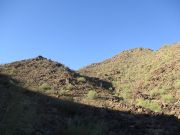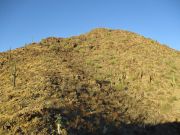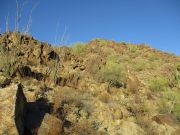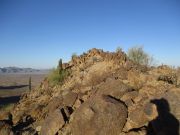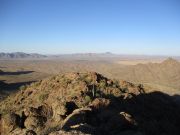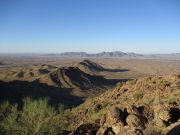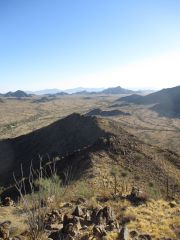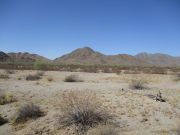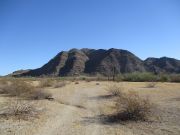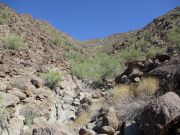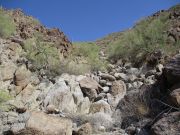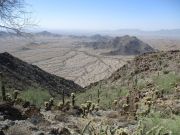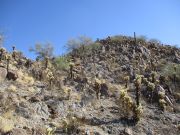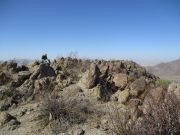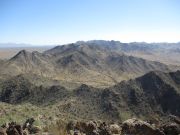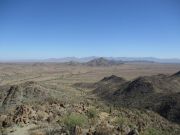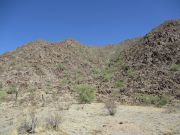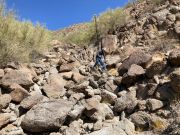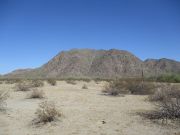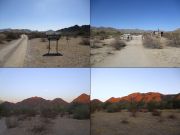
The Mountains of Arizona
www.surgent.net |
|
Peak 1924 • Peak 2126 (Sheep Mountain North) Matthias proposed three rocky peaks in the North Maricopa Mountains between Buckeye and Gila Bend. The three lie in a grouping south of Margies Peak and flank the Margies Cove trailhead and campground. This would be my first time tackling any desert peaks since last March, obviously avoiding them due to the summer heat. After seven months of mainly hiking mid- and high-elevation volcanic mounds and forested summits, being back on these rocky, steep, cactusy and pointy peaks was welcome, but admittedly, I was out of practice. I enjoy these North Maricopa Wilderness peaks. They tend to be steep and rocky, but almost always with rocks solidly in place and assuming a wise route is chosen, avoiding cliffs and other barriers. They just require a lot of uphill hiking over rocks big and small, a little scrambling here and there, and suddenly, you're on top.
Date: October 29, 2023
• Elevation: 1,924 feet
• Prominence: 724 feet
• Distance: 1.5 mile
• Time: 1 hour, 40 minutes
• Gain: 780 feet
• Conditions: Cool, clear, beautiful
• Teammate: Matthias Stender
• Prog rock bands played: Robert Wyatt, Matteo Mancuso
Arizona
•
Main
•
PB
•
LoJ
We met at the Wal-Mart off Dysart Road in Avondale/Goodyear. As usual, Matthias drove because his 4-Runner is better suited for the roads. We followed state route AZ-85 southbound about 15 miles to Woods Road, then east onto its sandy continuation, passing the sign mentioning the Sonoran Desert National Monument.
The main road goes east and passes south of Margies Peak. I climbed that peak in 2014, and this was my first time back since then. The roads are smooth in that there are virtually no rocks, but very uneven due to erosion, arroyos, and lack of upkeep. Some ruts would easily high-center most vehicles. High clearance is mandatory, 4-wheel drive would be nice to have.
Our first peak, Peak 1924, lies south of Margies Peak. We drove until we were slightly east of the peak, intending to follow a gently-sloped drainage up to the crest and then follow that to the top. We parked at nearly 7 a.m. exactly. It was cool, in the 50s, and calm and very pleasant, not a cloud in the sky. The full moon was setting in the west. Apparently, there had been a lunar eclipse the previous night but only visible in Europe, Asia and India, and barely in the eastern United States.
We started walking, entering into this broad drainage. On the range crest is a rocky knob. We debated whether to stay left or right. Staying left meant easier slopes but also meant having to cross over or around this knob. Staying right meant steeper slopes. We stayed left and were on the crest below this knob quickly, perhaps just 20 minutes.
Crossing over the knob was easy and we were now on the small saddle below the top, which rose about another 400 feet above us. But from where we stood, it looked friendly. It lay back, the slopes were mostly big rocks that appeared to be solid, and there were no obvious barriers.
This portion went well too and wasn't difficult. There was one rocky heap that required hands to get up and past. The slopes were gravelly but not treacherous. And then, we were on top the peak, 48 minutes said Matthias. It seemed to go by fast.
The top is rocky but with open spots to sit. We found a register and signed in. Bob Packard was the last to sign in, in 2015. The names went back to the 1990s and were just the familiar ones: MacLeod & Lilley, Bob Moore, Scott Kelley, and a couple of others.
Views were very good as we had clear conditions and no humidity. We spent about ten minutes up here looking around. The breeze picked up but it felt good. This was an enjoyable climb and there was no rush to get moving down. We followed the same route for the descent, and were back to Matthias' vehicle about 8:40.
We drove east a little more, then south onto a spur road that leads to the Margies Cove Trailhead. There were two more peaks on the agenda: Peak 2126 which lies east, and Peak 1725, which lies southwest. We chose the bigger one first.
Elevation: 2,126 feet
• Prominence: 526 feet
• Distance: 2.1 miles
• Time: 3 hours
• Gain: 1,000 feet
• Conditions: Warmer but still very pleasant
PB
•
LoJ
We were moving within minutes after parking. It's about a half-mile walk across the desert flats, passing through one fence opening along the way, to get to the base of the peak.
The ascent drainage looks steep and intimidating from a distance, almost looking vertical. But once at its foot and looking up, it lays back so that climbing it is not some rock-climbing ordeal. The transition from desert flats to the rocky base of the peak is very sudden. Within feet, we went from sandy ground to big boulder heaps.
We worked up one slope of boulders, gaining about a hundred feet, before entering into the drainage itself. From here to the high ridge, we'd be going from one rock to another, up dryfalls and chaotic heaps of rock. There was always some alternative to get around anything too imposing. Early on, I thought that if it stays like this all the way up, we'll be fine. I half expected we'd get to some cliff at the top that would stop us.
At no time was the clambering anything beyond Class 2 or low Class 3. There were always hand- and foot-holds and safe options around some more exposed segments. Palo verde grew in the drainage which forced us to go up the banks and around, which could get sloppy. I was using my hands consistently to hoist up three-foot steps. It was easy but tiring. The rocks stayed in place almost all the time. Just a few moved. Each one was tested beforehand, as always. It went on like this all the way to the top.
The drainage loses distinction as it nears its headwall and the crest. This final hundred feet was more open, more loose and less secure, with more cholla than down below. It wasn't difficult, but I moved slowly. We took a break on the range crest itself. We were less than 75 feet below the summit, sitting below its little summit hill.
After the break, we walked up the rocky summit hill and onto the summit ridge, which runs about 150 feet in length and is flat enough so that any of about five different rocks could be the highest point. The presumptive highpoint is at the south end of the ridge, where we found a register and signed in (the same crowd as on our first peak, with no one since Bob in 2015 until us. Someone on Peakbagger had logged a visit in 2022, but did not sign the register). We took another longer break here and looked around.
A rock on the north tip of this ridge appeared to be higher than the southern rocks, and using my water bottle as a level, affirmed that it very likely is, by about a foot. I don't think it matters in the bigger picture. We had walked from that way and would return that way and tagged it each time.
The descent was actually a lot of fun, except when I sat in a pile of old cholla bulbs some packrat had collected. Only that hundred-foot segment descending back to the drainage went slow, trying to avoid skiing on the gravel. But once in the drainage, it was far easier.
Much of the downclimb was butt-scooting down the rocks, hoisting down through narrow openings and hopping from one to the next. I wouldn't say it went fast. It was just easier. However, it was tiring. I was getting a full body workout, I could really feel the fatigue in my hands, arms and shoulders. It took us about an hour to downclimb the drainage and get back onto the desert flats.
Back at the car, I told Matthias I was done for the day. I was exhausted. He wanted to go tag Peak 1725, so I said go for it. I stayed back at the car and took a 45-minute nap, plus walked a little bit of the Margies Cove trail. It was utterly silent here. No other cars came by. I enjoyed the quiet and solitude and the rest. Matthias was back a little after 2 p.m.. We returned to the Wal-Mart where we divvied gear and parted ways, thankful again for a successful day on the peaks and Matthias for the driving. One of his selections was by Robert Wyatt, an original member of Soft Machine who recorded some tracks in 1968, one of which featured Jimi Hendrix on bass guitar.
I don't get to this Wal-Mart area often, but when I do, I like to reward myself with a Hawaiian barbecue meal from a place nearby. They were crowded today, and for good reason. For $15, you get about $30 worth of food and it's very good. I was home by 4:30.
|
|
